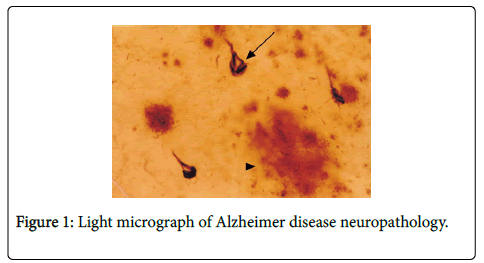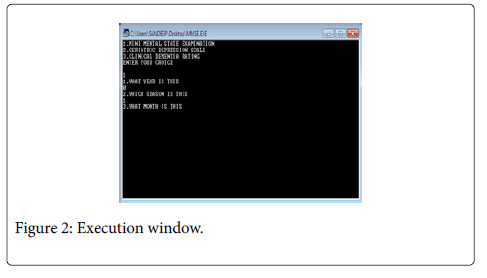Review Article, Adv Biomed Res Innov Vol: 1 Issue: 2
Dementia Screening Tool for the Early Diagnosis of Alzheimer’s Disease
Sandeep CS1*, Sukesh KA1, Mahadevan K2, Manoj P3 and Praveen P3
1CET, Trivandrum, University of Kerala, Kerala, India
2Department of Ophthalmology, Sree Gokulam Medical College and Research Foundation, Trivandrum, Kerala, India
3Department of Neurology, Sree Gokulam Medical College and Research Foundation, Trivandrum, Kerala, India
*Corresponding Author : Sandeep CS
CET, Trivandrum, University of Kerala, Kerala
E-mail: sandeepcs07nta@gmail.com
Received: February 24, 2018 Accepted: April 16, 2018 Published: April 23, 2018
Citation: Sandeep CS, Sukesh KA, Mahadevan K, Manoj P, Praveen P (2018) Dementia Screening Tool for the Early Diagnosis of Alzheimer’s Disease. Adv Biomed Res Innov 1:2. doi: 10.4172/ABRI.1000104
Abstract
Alzheimer’s disease (AD) is one of the most devastating type brain diseases. The most important task is to predict the disease at an earlier stage to avoid complications. In this regard a reliable and efficient method should be developed with the help of Biomedical Engineering Technology. In this research paper we have developed a technique based on Mini Mental State Examination to screen the disease at different stages. This software tool can be used as a medical aid for doctors for diagnosing the disease.
Keywords: Alzheimer’s disease; Dementia; Early diagnosis; MMSE
Introduction
The early prediction of Alzheimer’s disease (AD) is an important part for delaying the disease from its progression at the initial stage [1,2]. The basis of diagnosing AD follows the Alzheimer’s Disease and Related Disorders Association (ADRDA) and National Institute of Neurological and Communicative Disorders and Stroke (NINCDS) [3,4]. AD is a neurological dysfunction creating leading different memory problems [5]. Globally, around eleven million people were affected with Alzheimer’s disease, 2001. Today thirty six million people are having AD or other dementias. This will increase to sixty six million by 2030 and one hundred and fifteen million by 2050 [6]. The different stages of progression of the disease are classified as Mild, Moderate and Severe [7]. If we can identify the stages earlier, it will be a better relief to AD patients.
Neurofibrillary tangles and senile plaques are the two prominent risk factors or hallmarks of AD [8,9]. The other factors that lead to AD include genetic changes, female gender, trauma history and lower intelligence [10,11]. The Figure 1 shows the Light micrograph of Alzheimer disease neuropathology. The arrow shows tangle and the arrow head shows plaque. There are different tests such as clinical tests, Neuroimaging tests and neuropsychological tests to diagnose AD. These tests are used to find out the variations in brain atrophy. The neuropsychological tests include Clock Drawing task, Mini Mental State Examination (MMSE) and Trial Making Test parts A and B [12].
The tests mentioned above can be useful to determine the memory recall of an AD patient and also to find the areas where the patient lacks deficiency. A group study is required and necessary for making an effective and early diagnosis of AD. An efficient prediction of the disease can be made by conducting clinical trials and combining neuropsychological tests with clinical tests and various imaging modalities. In this paper we have followed a neuropsychological test known as MMSE and developed a software tool based on MMSE. This is made successful with the help of C language, a powerful, reliable and efficient programming tool. This tool can be considered as an AD progression finding method before diagnosing the disease. Before going to diagnose AD with other invasive and noninvasive tests this software can be used effectively for a correct treatment.
Materials and Methods
The Mini Mental State Examination helps in systematically and thoroughly assesses mental status [13]. MMSE is an eleven question measure technique that lasts for 5 minutes. It is used to test the most important areas of cognitive function such as orientation, registration, attention and calculation, recall, and language.
The physician will ask the patient related to the cognitive function mentioned above and give marks out of thirty. A score of twenty three or lower indicates an alarm of cognitive dysfunction [14,15]. The MMSE technique can be used as an effective screening method to separate patients with cognitive dysfunction from normal. MMSE method is able to find out changes in cognitive status that may benefit from involvement [16,17]. MMSE method depends on verbal response and reading and writing. The performance of patients with hearing and visually impaired, low English literacy, or other communication disorders is poor. In this research paper we have overcome the communication problem of virtually impaired patients [17].
The next step is to develop an assessment tool based on MMSE. In this paper we use the powerful and most reliable language C.C is one of the most popular programming languages in existence in areas of embedded systems. C language is used for writing programs in different domains, such as operating systems, numerical computing and applications on graphical areas. In this regard we have developed this neuropsychological tool with the help of C language. C language can be used to analyze and compare the different aspects of MMSE. We have made the MMSE questionnaire as an executable file that run on any platform or operating systems. The size of memory required for this executable file is 33,875 bytes (33 kilobytes). Thus it saves memory and it is also portable and economical.
Results and Discussion
The experiments for diagnosing AD using the developed software have been conducted in Sree Gokulam Medical College and Research Foundation with the help of neurologists. The experiments conducted on AD and non-demented patients. The tool thus developed can be summarized as shown in Table 1. It has four methods for its execution the first method is a single cut off method to rule out whether the patient is having cognitive impairment or not. The second method shows the chance of getting dementia.
| Method | Score | Interpretation |
|---|---|---|
| Single cutoff | ˂24 | Cognitive impairment |
| Range | ˂21 | Dementia chance increases |
| ˃25 | Dementia chance decreases | |
| Education | 21 | 8th grade education |
| ˂23 | high school education | |
| ˂24 | college education | |
| Severity | 24-30 | No cognitive impairment |
| 18-23 | Mild cognitive impairment | |
| 10-17 | Moderate cognitive impairment | |
| <10 | Severe cognitive impairment |
Table 1: Summarized table of the neuropsychological test.
If the dementia score is less than 21; there is a great chance of dementia ad if the range is greater than 25; there is a decreased chance of getting dementia. The third method of execution depends on education. It has three sections. If the patient has only 8th grade education, the sore lower than or equal to 21 shows dementia. If the patient has high school education and the score lower than 23 shows dementia. If the patient is having college education and the score lower than 24 shows dementia. The fourth method depends on the severity of the disease which is widely used one.
From the different methods we can see that the developed test based on MMSE depends not only on the score obtained but also on different criteria such as education. Before applying this test on patients we must have an exact idea about the education of the subject otherwise the result may vary.
The window obtained during the execution is shown in Figure 2. We have developed this tool for mainly three tests such as MMSE, Geriatric Depression Scale and Clinical dementia rating, but we have concentrated on MMSE only. As shown in the window if the choice 1 is entered, different questions will appear one by one and we can give mark one or zero if the patient answered correctly or not. After entering all the questions a final score is obtained which is the dementia score that depends on the methods discussed in Table 1.
Conclusion
There are different techniques and clinical trials available for the prognosis of Alzheimer’s disease. For an efficient diagnosis at the initial stages, these techniques are inadequate. So this software can be used as a reliable and efficient method before diagnosing the disease without going to a critical stage. This software can be made in conjunction with the advanced Biomedical Engineering technology for better diagnosis of the disease. In the future expansion of this tool we can add more neuropsychological tests to make an exact screening of dementia. Further we can add certain software for AD patients with disabilities in speaking, hearing and visual.
References
- CS Sandeep, KA Sukesh (2015) A Review on the Early Diagnosis of Alzheimer’s Disease (AD) through Different Tests, Techniques and Databases. AMSE JOURNALS 76: 1-22.
- CS Sandeep, KA Sukesh (2017) A Psychometric Assessment Method for the Early Diagnosis of Alzheimer’s disease, International Journal of Scientific & Engineering Research.
- Hy LX, Keller DM (2000) Prevalence of AD among whites: a summary by levels of severity. Neurology 55: 198-204.
- Chu LW, Tam S, Wong RL (2010) Bioavailable testosterone predicts a lower risk of Alzheimer’s disease in older men. J Alzheimers Dis 21: 1335-1345.
- CS Sandeep, KA Sukesh, Mahadevan K (2017) Dimensionality Reduction of Optical Coherence Tomography Images for the Early Diagnosis of Alzheimer’s Disease. American Journal of Electrical and Electronic Engineering 5: 58-63.
- 2010 Alzheimer's Disease Facts and Figures (2010) Alzheimer's Association. Alzheimer's and Dementia, Chicago.
- Prince M, Bryce R (2011) Alzheimer’s disease International, World Alzheimer Report. The benefits of early diagnosis and intervention. Institute of Psychiatry, King’s College London.
- AA (2012) Alzheimer’s Facts and Figures. Alzheimer’s Association.
- WAD (2011) World Alzheimer’s Day on Wednesday.
- Frosch MP, Anthony DC, Girolami UD (2010) The Central Nervous System. In: Robbins and Cotran Pathologic Basis of Disease. Elsevier 10: 1313-1317.
- Harvey RP, Champe PC, Fisher BD (2006) Lippincott’s Illustrated Reviews: Microbiology (2nd Edtn.) Lippincott Williams and Wilkins.
- Cummings JL, Vinters HV, Cole GM, Khachaturian ZS (1998) Alzheimer’s disease: etiologies, pathophysiology, cognitive reserve and treatment opportunities. Neurology 51: 2-17.
- Scarmeas N, Luchsinger JA, Schupf N (2009) Physical activity, diet, and risk of Alzheimer disease. JAMA 302: 627-37.
- Pangman VC, Sloan J, Guse L (2000) An Examination of Psychometric Properties of the Mini-Mental State Examination and the Standardized Mini-Mental State Examination: Implications for Clinical Practice. Appl Nurs Res 13: 209–213.
- Tombaugh TN, McIntyre NJ (1992) The mini-mental State Examination: A comprehensive Review. J Am Geriat Soc 40: 922–935.
- Tuijl JP, Scholte EM, de Craen AJM, van der Mast RC (2012) Screening for cognitive impairment in older general hospital patients: comparison of the six-item cognitive test with the Mini-Mental State Examination. Int J Geriatr Psychiatry 27: 755–762.
- Folstein MF, Folstein SE, McHugh PR (1975) Mini-mental state. A practical method for grading the cognitive state of patients for the clinician. J. Psychiat. Res 12: 189–198.
 Spanish
Spanish  Chinese
Chinese  Russian
Russian  German
German  French
French  Japanese
Japanese  Portuguese
Portuguese  Hindi
Hindi 


